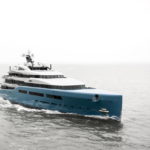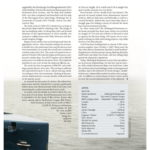»Aviva« is the longest yacht ever built by German shipbuilder Abeking & Rasmussen. As a special, the recently delivered vessel features a hybrid drive. More yachts of this size are to follow
When the contract was signed almost three years ago, the traditional shipyard on the banks of the Weser did not[ds_preview] even have a suitable site. Until then, Abeking & Rasmussen had built yachts with a maximum of 85m. After the search for a suitable location had been unsuccessful, an existing hall F on the site in Lemwerder was extended without further ado. The family-run shipyard headed by Hans Schaedla invested 20 mill. € in its future.
At the inauguration two years ago, just in time for the 108th anniversary of the company, the stern and bow sections of the future »Aviva« were already under construction in the hall and were immediately united after the ceremony. The steel hull was supplied by the Flensburger Schiffbaugesellschaft (FSG) while Stahlbau-Nord in Bremerhaven had prepared two aluminum deck sections, and the ship, hull number 6501, was then completed and launched with the help of the Norwegian heavy duty barge »Boabarge 36« in Lemwerder in January 2017. Finally, »Aviva« was delivered in May.
The sleek yacht of 5,000 GT is about twice as large as the private ships built by Abeking so far. The design of the newbuilding with a striking blue hull and beveled elements of the superstructure in silver metallic was created in collaboration with Toby Silverton and Reymond Langton Design.
Elegance and comfort were in the foreground when designing the »Aviva«. After extensive testing, the extremely slender bow, the underwater lines and the stern section were streamlined. As a result, the overall water resistance could be reduced by 20%. The yacht will speed to the required 20 knots with reduced engine performance compared to similar ships. Two MTU engines with 2,800 kW each power two shafts for the direct drive. This holds the potential to save a lot of fuel, the shipyard officials say.
The yacht also has two gensets of 600 kW each enabling a purely electric drive also. This setting is sufficient for a speed level of up to 11 kn in »silent running« mode. According to their own statements, Abeking & Rasmussen has implemented a concept already tried and tested in the marine sector.
As a benefit for the owner of »Aviva«, the reduced engine power and the hybrid drive concept significantly reduce noise and vibration loads while at the same time increasing the comfort aboard the luxury yacht.
As usual, only few details are known about the construction of such ships. British businessman Joe Lewis is reported to be the owner of the »Aviva«. Lewis, who owns, among others, the Premier League club Tottenham Hotspurs, is said to have assets of 4 bill. £ (4.5 bill. €). Being an enthusiastic tennis player, he had his own paddle tennis court being installed on the ship. At 20m in length, 10m width and 6.50m height this sports facility extends over two decks.
Even beyond, »Aviva« hardly lacks any features. The specials on board include three-dimensional interior surfaces, fold-out balconies and bulwarks as well as a covered foredeck. Behind the usual outer flaps there is enough space for hiding a variety of vehicles for shore leave and recreational activities.
So, what comes next? The Abeking & Rasmussen order book currently lists three more yachts, two of which at a length of 75m and one of 80m, so the yard is used to capacity for the time being. »Of course, we are constantly working on other interesting projects,« says Sales Director Uwe Kloschinski.
A & R has been looking back on almost 6,500 construction numbers since October 1, 1907. Those were the days when Henry Rasmussen founded a small boatbuilding business with his partner Georg Abeking. Initially, small boats and ships were built, and fast sailing ships gained the shipyard a reputation.
Today, Abeking & Rasmussen is one of the top addresses in German shipbuilding. For the first time in Europe, fully welded aluminum ships were built here. Later the yard launched newbuildings made of demagnetized stainless steel to be followed by Swath designs, double-hulled semi-submersibles mainly for pilots and coast guards. In addition to naval and government vessels, yachts are now the second and main pillar of the shipyard.




















